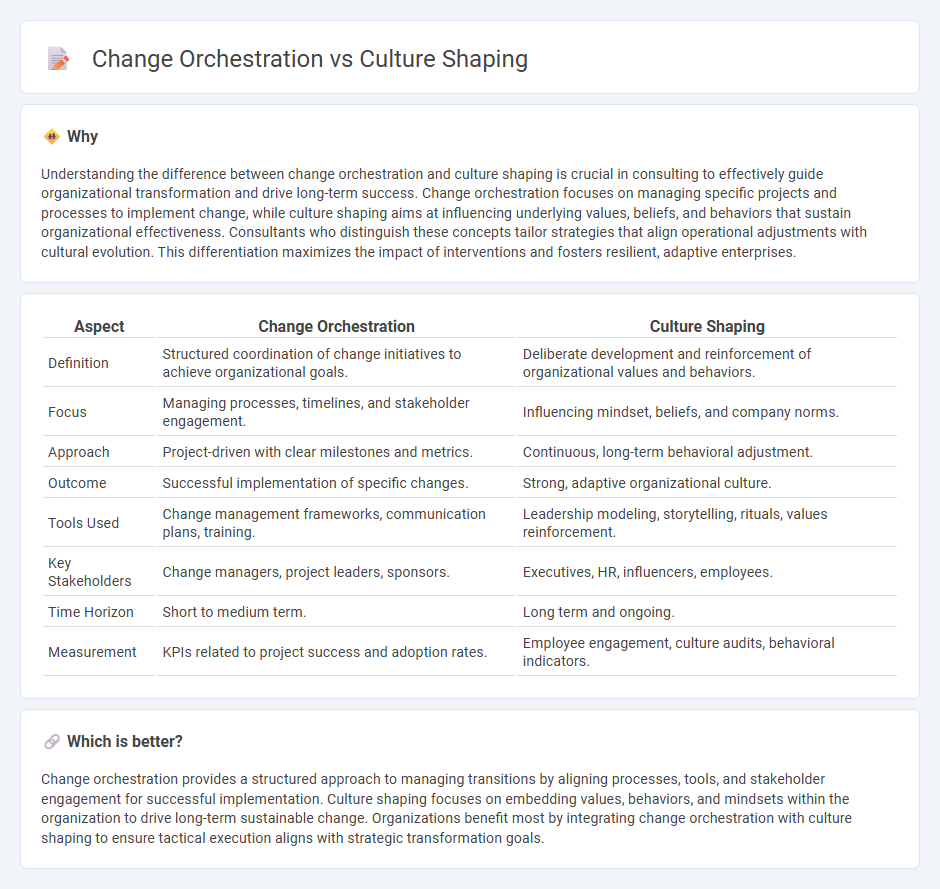
Change orchestration aligns strategic initiatives with operational execution to ensure smooth transitions and measurable outcomes in organizational transformation. Culture shaping focuses on embedding core values, behaviors, and mindsets to cultivate a resilient and adaptive workforce that sustains long-term growth. Discover how integrating both approaches drives comprehensive organizational success.
Why it is important
Understanding the difference between change orchestration and culture shaping is crucial in consulting to effectively guide organizational transformation and drive long-term success. Change orchestration focuses on managing specific projects and processes to implement change, while culture shaping aims at influencing underlying values, beliefs, and behaviors that sustain organizational effectiveness. Consultants who distinguish these concepts tailor strategies that align operational adjustments with cultural evolution. This differentiation maximizes the impact of interventions and fosters resilient, adaptive enterprises.
Comparison Table
| Aspect | Change Orchestration | Culture Shaping |
|---|---|---|
| Definition | Structured coordination of change initiatives to achieve organizational goals. | Deliberate development and reinforcement of organizational values and behaviors. |
| Focus | Managing processes, timelines, and stakeholder engagement. | Influencing mindset, beliefs, and company norms. |
| Approach | Project-driven with clear milestones and metrics. | Continuous, long-term behavioral adjustment. |
| Outcome | Successful implementation of specific changes. | Strong, adaptive organizational culture. |
| Tools Used | Change management frameworks, communication plans, training. | Leadership modeling, storytelling, rituals, values reinforcement. |
| Key Stakeholders | Change managers, project leaders, sponsors. | Executives, HR, influencers, employees. |
| Time Horizon | Short to medium term. | Long term and ongoing. |
| Measurement | KPIs related to project success and adoption rates. | Employee engagement, culture audits, behavioral indicators. |
Which is better?
Change orchestration provides a structured approach to managing transitions by aligning processes, tools, and stakeholder engagement for successful implementation. Culture shaping focuses on embedding values, behaviors, and mindsets within the organization to drive long-term sustainable change. Organizations benefit most by integrating change orchestration with culture shaping to ensure tactical execution aligns with strategic transformation goals.
Connection
Change orchestration and culture shaping are interconnected through their focus on aligning organizational behaviors and values with strategic goals. Effective change orchestration ensures smooth transitions by engaging stakeholders, while culture shaping fosters an environment that embraces adaptability and continuous improvement. Together, they drive sustainable transformation and enhance organizational resilience.
Key Terms
Organizational Alignment
Organizational alignment is crucial for effective culture shaping and change orchestration, as it ensures that every team member's values and goals are synchronized with the company's vision. Aligning leadership strategies with employee behaviors drives sustainable transformation and strengthens overall corporate identity. Explore how mastering organizational alignment propels cultural evolution and change management success.
Leadership Engagement
Leadership engagement plays a pivotal role in culture shaping by embedding core values and behaviors through consistent communication and example-setting, fostering an environment of trust and alignment. In change orchestration, leaders strategically guide transitions by managing resistance, driving collaboration, and reinforcing new practices to ensure sustained transformation. Explore effective leadership strategies to master both culture shaping and change orchestration for organizational success.
Behavioral Reinforcement
Behavioral reinforcement plays a critical role in culture shaping by consistently promoting desired behaviors that align with organizational values and goals. Change orchestration leverages behavioral reinforcement techniques to facilitate adaptive responses and embed new practices during transitions. Explore best practices in behavioral reinforcement to effectively shape culture and drive successful change initiatives.
Source and External Links
10 Things Great Leaders Do to Shape Culture - Aga Bajer - Great leaders intentionally shape organizational culture by taking it seriously, creating a shared vision aligned with company goals, hiring accordingly, and engaging staff to define the desired culture's visible manifestations, recognizing culture as a key driver of success.
Culture shaping - The Lime Group - Culture shapes how people think, feel, and behave in organizations, fundamentally influencing strategy execution, and expert culture shaping involves defining culture, aligning it with strategy, and building capabilities to foster communication, learning, and sustainable competitive advantage.
What You Should Know About Shaping Organizational Culture | CCL - Organizational culture encompasses shared habits and beliefs about how things should be done, subtly influencing behaviors and workplace dynamics; leaders shape culture through reinforcement of intended behaviors and norms, which is crucial especially in global or hybrid workforce settings.
 dowidth.com
dowidth.com